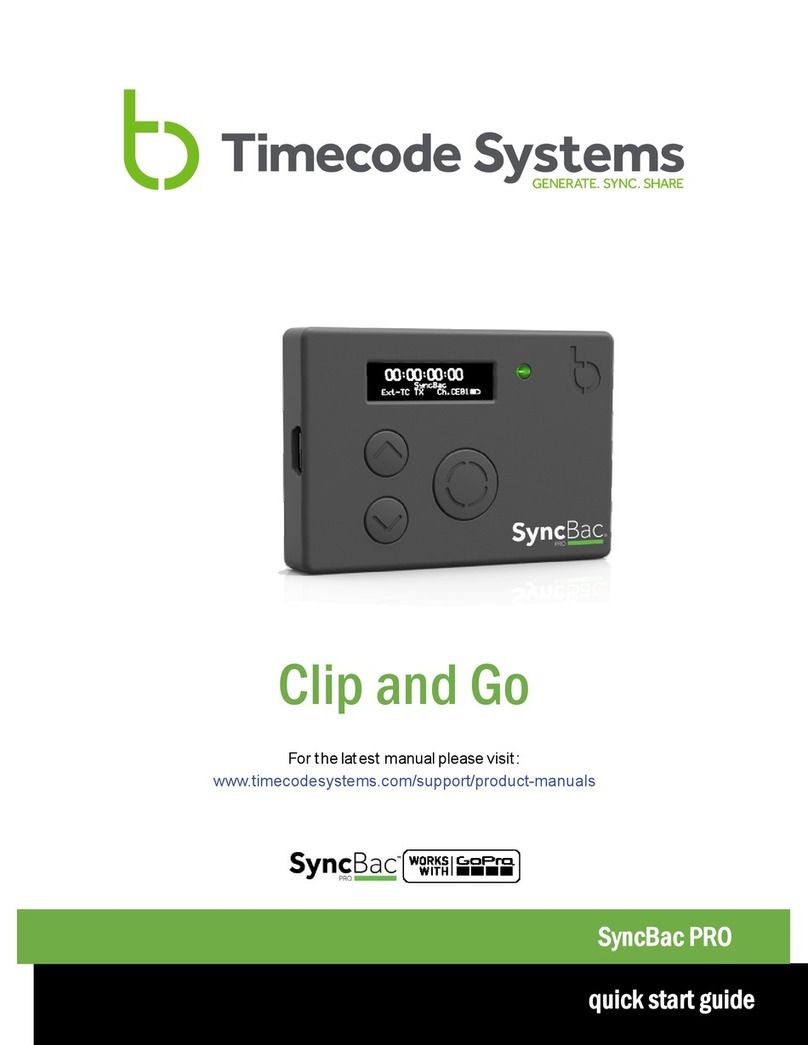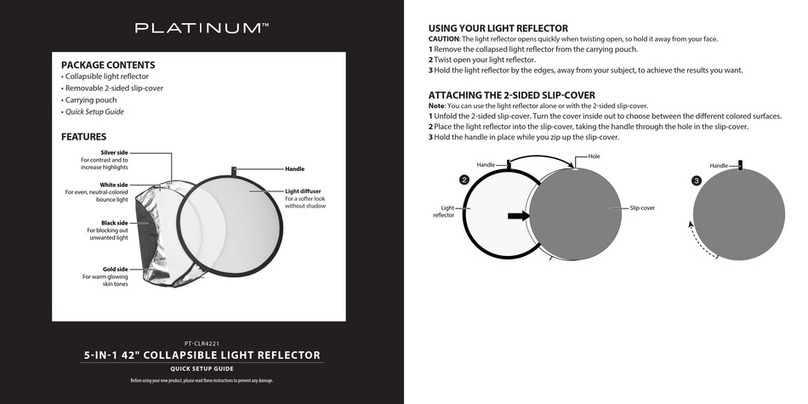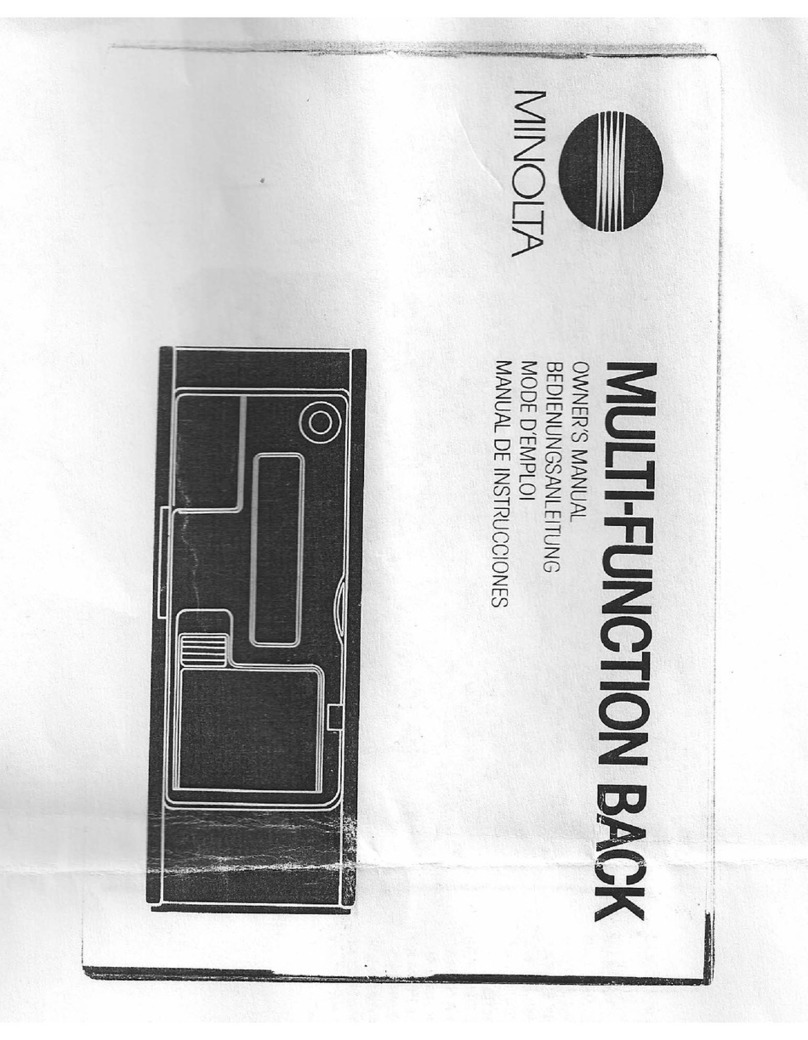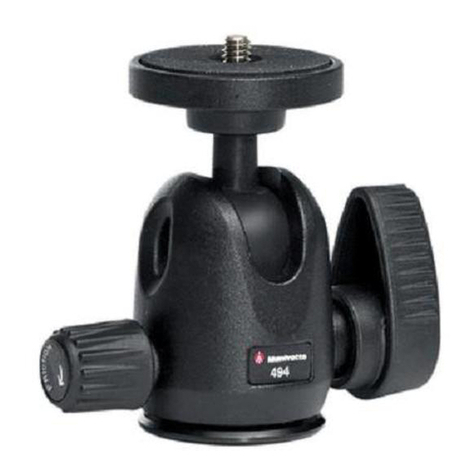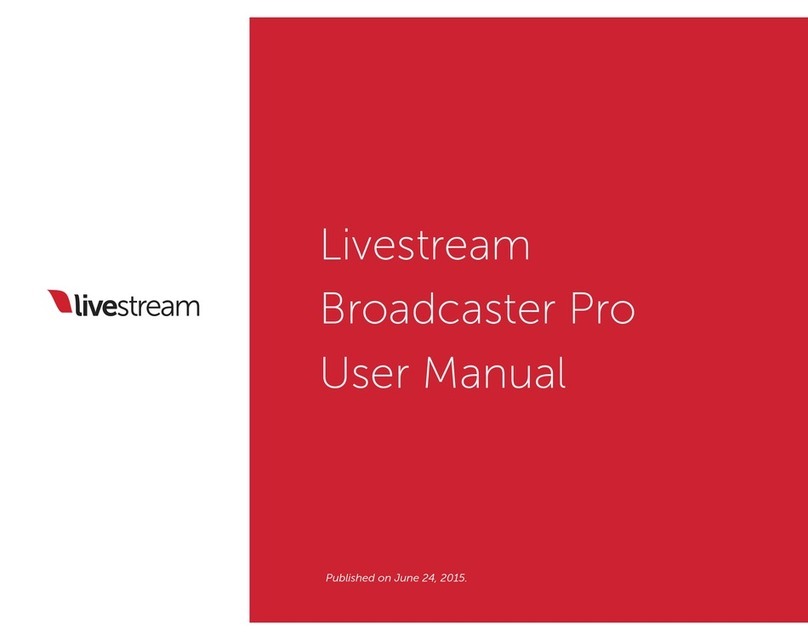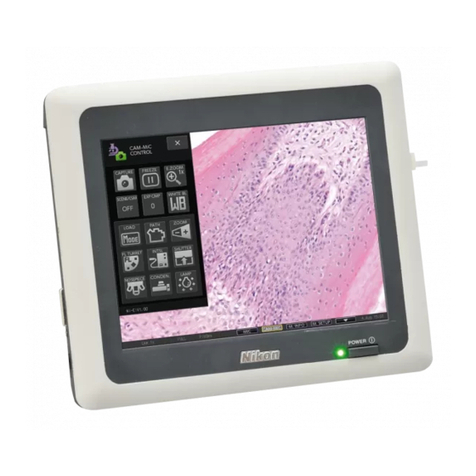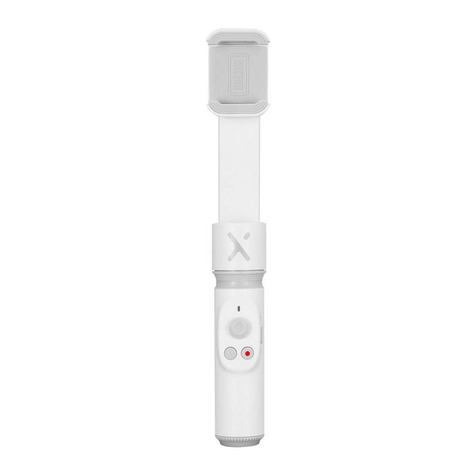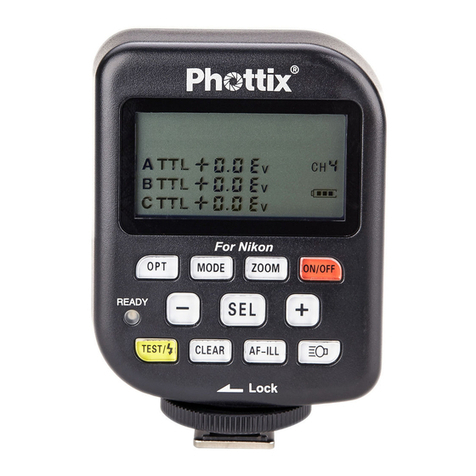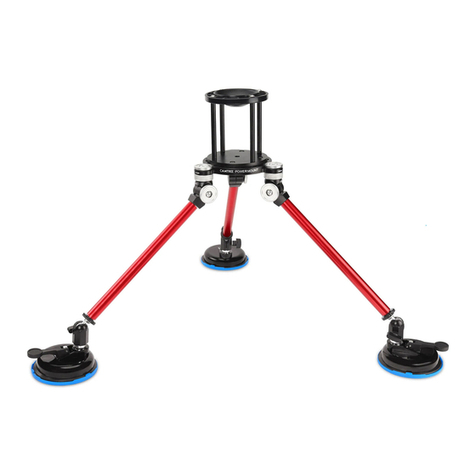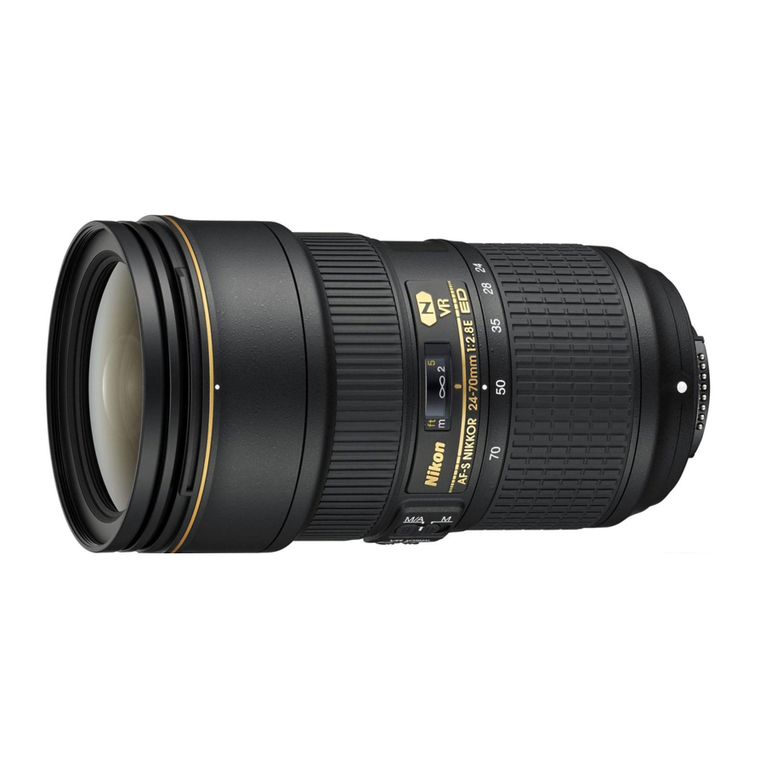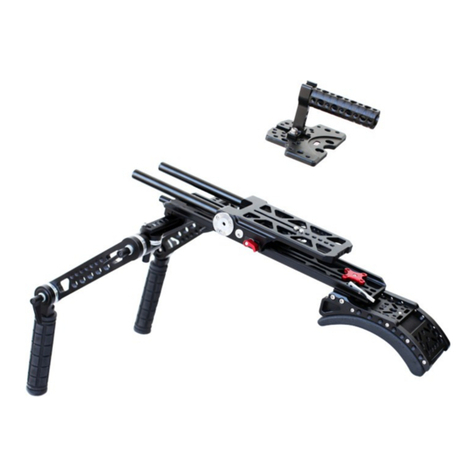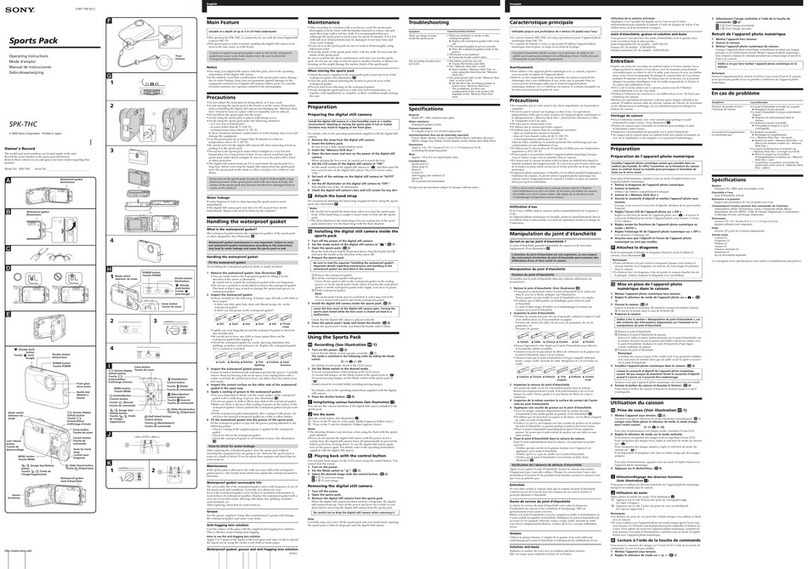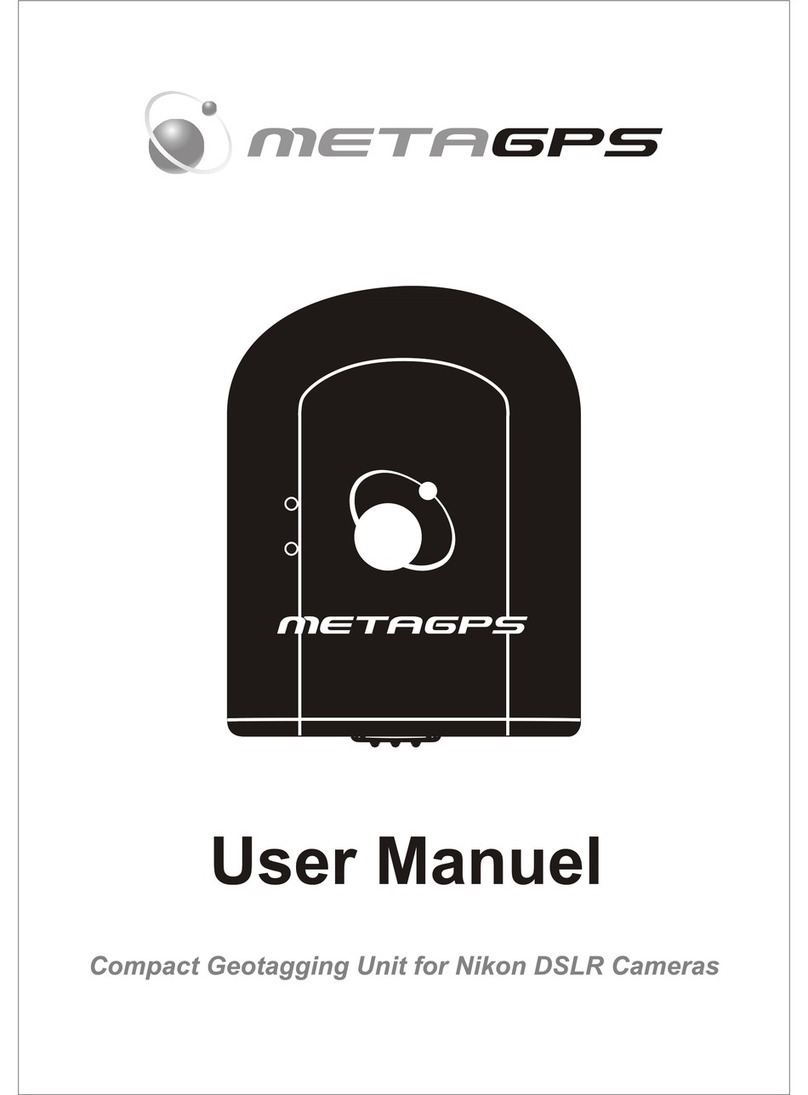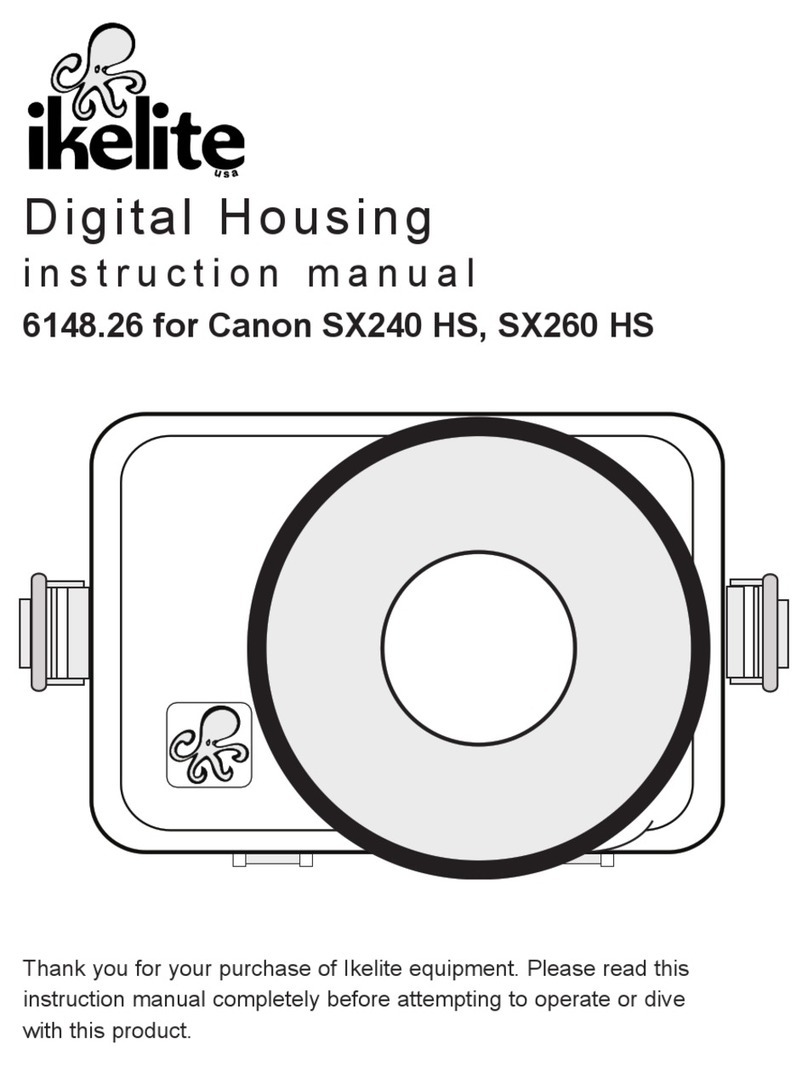timecode systems AirGlu2 User manual

UK Timecode Systems Ltd. Unit 6, Elgar Business Centre, Moseley Road, Hallow, Worcester.
WR26NJ. UK
User Manual v1.5 (dated 26/05/2022)
Key Features
The AirGlu2™ module highlighted features are listed below:
•Configurable Sync and Control module for sync and control of
professional cameras, recorders and audio devices
•Built in Timecode Generator, with 0.5ppm VC TCXO
•Timecode Input and Timecode output modes
•Master or Slave operation modes
•Genlock and Word Clock sync outputs
•Sync and Control wireless using sub-GHz protocol, transmit and
receive.
•External antenna port
•Additional connectivity to apps, using 2.4GHz Bluetooth LE.
•2.0v and 3.3v regulated inputs
•UART to host equipment with buffered data inputs
•Simple serial UART API for all menu and control functions
•Single power and I/O port
•Surface Mount module
Wireless Sync and Control
AirGlu2™ module

UK Timecode Systems Ltd. Unit 6, Elgar Business Centre, Moseley Road, Hallow, Worcester.
WR26NJ. UK
System Overview
Introduction
The AirGlu™ module is an energy friendly, compact solution for
providing wireless sync and control capabilities to a professional
camera, recorder or audio device.
It combines integrated MCU/2.4GHz transceiver, FPGA and Sub GHz
radio transceiver.
A highly accurate 0.5ppm TCXO provides stable timecode and sync
outputs.
It can communicate via Sub GHz radio to other AirGlu™ and
AirGlu2™ modules or to 3rd party applications using the 2.4GHz
Bluetooth LE radio.
It has and external internal antenna port and can be surface mounted
into a host PCB.
It is extremely compact at 22 mm x 16 mm.

UK Timecode Systems Ltd. Unit 6, Elgar Business Centre, Moseley Road, Hallow, Worcester.
WR26NJ. UK
System Overview
Serial UART API – S1C Commands
API V5.4
Getting/Changing Configuration Settings of S1C enable devices
All commands are formed normally using text-based strings and communicated to
the device by one of the following methods.
A bi-directional serial link. The link will currently be based around a logic level
serial port with or without CTS/RTS handshake with a default baud rate of
57600. Note that TCS standard serial I/O will not tolerate full RS232 voltage
levels, also RS232 has inverse logic.
For Bluetooth Low Energy enabled devices.
The method to be used to read or change values with the System One Controller
(S1C) using simple control request messages. These requests can be to retrieve
information or to change settings. The S1C will respond back the requested data or
acknowledgment of changes made.
All control messages and replies can be checked using simple terminal software, i.e.
Teraterm for serial links
Command Syntax
Commands and replies are formed as readable ASCII strings.
Commands/queries/replies start with a ‘#’, this start character is followed by the
command/query string which is then followed by a ‘?’ for queries or an ‘=’ for
commands/replies.
All commands and queries are case sensitive, currently all upper-case and 4 ASCII
characters long - excluding ‘#’, ‘=’ or ‘?’.
All commands and queries must be terminated with a <LF> or a <CR>+<LF> (0x0a
or 0x0d,0x0a)[‘\n’ or ‘\r\n’]. All non-binary replies will be terminated with a single
<LF>
Command value strings must not exceed 112 bytes to be compatible with the BLink
network.

UK Timecode Systems Ltd. Unit 6, Elgar Business Centre, Moseley Road, Hallow, Worcester.
WR26NJ. UK
Binary Commands
Commands or queries requiring binary data are identified with different assignment
characters as follows.
‘>’ Binary set (same as text command’s ‘=’)
‘<’ Binary get (same as text command’s ‘?’)
Following the assignment character is a single length byte which denotes the length
of the following binary data. If there is no binary data to follow then this length byte
should be zero. The length byte should then be followed by the first byte of the
binary data. The binary data (or zero length byte) still requires to be followed with a
‘\n’ termination character.
“#BCMD>Length+Binary Data\n”
Multiple Commands per line
Multiple commands can be placed on a single command line. This is most useful for
BLink commands/queries to a single remote device as multiple commands on a
single line will be transmitted to the remote device in a single frame period i.e.
quicker. Multiple commands should be separated with the ‘:’ (full colon) character.
Each line, not each command, should be started with the ‘#’ character and
terminated with a ‘\n’.
“#TCTM?:TCUB?:RFTX=1:BINC>\04****\n”
Replies to multiple commands may be returned separately.
It must be remembered that there is a line length limit of 112 characters.
BLink Network Commands
BLink network device addressing is slightly different, please see later section on
‘Blink Networks’ for full details.

UK Timecode Systems Ltd. Unit 6, Elgar Business Centre, Moseley Road, Hallow, Worcester.
WR26NJ. UK
Timecode Source
TCSC? Returns the current timecode source as a string TCSC=n where n is an
ASCII ‘0’ through ‘2’ where;
0 = Internal (free run)
1 = External RF
2 = External RF (Cont) Free run between sync packets.
3 = External LTC
4 = External LTC (Cont) Free run if signal removed
TCSC=n Sets the timecode source to the value n as in the list below. The S1C
will reply with the currently set source where;
0 = Internal
1 = External RF
2 = External RF (Cont)
3 = External LTC
4 = External LTC (Cont)
5 = Jam once to RF then go to Internal mode
6 = Jam once to LTC then go to Internal mode
Timecode
TCTM? Returns the current timecode as a string
“TCTM=hhmmssff”
TCTM=hhmmssff Sets the current Timecode (only if in ‘Internal’ Mode)
User-Bits (also see RF Userbits)
TCUB? Returns the current User Bits
TCUB=uuuuuuuu Sets the current User Bits (only if in ‘Internal’ Mode or RF
userbits switch (RFUB) is off)
Broadcast Timecode *
TCBC=n Will configure the unit to broadcast on the serial output a
‘#TCTM=hhmmssff’ string periodically.
TCBC=0 Turn off broadcast
TCBC =1 Send Timecode once a second on frame 10. Frame 10 allows easy
offset adjustment to what is used/displayed.
TCBC=2 Send Timecode every frame.
Timecode Run/Freeze *
When the Timecode source is set to a non-continuous mode the output Timecode
will ‘freeze’ until the incoming signal is seen, triggering a running the Timecode.
Whereas continuous modes will continue to run the Timecode in the absence of and
external signal and then ‘soft-lock’ when the signal is re-established. These functions
can override the standard behaviour.
TCRN? Returns whether Timecode is running (=1) or frozen (=0).

UK Timecode Systems Ltd. Unit 6, Elgar Business Centre, Moseley Road, Hallow, Worcester.
WR26NJ. UK
TCRN=n Sets the Timecode to run (n=1) or freeze (n=0).
Frame Rate *
TCFR? Returns the current frame rate (Frames per Second) and whether using
Drop-Frame encoding of the timecode data. Returns TCFR=n,d where n is the FPS
value*1001 and d is a flag of whether using drop-frame encoding or not;
24000,0 = 23.98 fps (Non Drop-Frame)
24024,0 = 24 fps
25025,0 = 25 fps
30000,0 = 29.97 fps
30000,1 = 29.97 fps Drop-Frame
30030,0 = 30 fps
30030,1 = 30 fps Drop-Frame
The function will accept double frame rates, as follows but will return the standard
rate value in response and for subsequent queries.
48000,0 = 47.96 fps (Non Drop-Frame)
48048,0 = 48 fps
50050,0 = 50 fps
60000,0 = 59.94 fps
60000,1 = 99.94 fps Drop-Frame
60060,0 = 60 fps
60060,1 = 60 fps Drop-Frame
TCFR=n,d Sets the current frame rate & drop frame to the values n,d as in the list
above. The return value must be checked as illegal values will be ignored or
changed to the nearest value.
If changing the frame rate then the TV Sync standard may also change. It is
important that the TV Sync value must be read and displayed after any changes to
the FPS.
Genlock or Sync Standard
GLSD? Returns the current TV sync (Genlock) method as a string GLSD=n
where n is an ASCII 0 through 13 where;
0 = Off
1 = PAL
2 = NTSC
3 = 720p
4 = 720p x2 (double rate)
5 = 1080i
6 = 1080p
7 = 1080p x2
8 = LTC (Timecode)
9 = 44.1 KHz Wordclock
10 = 88.2 KHz Wordclock
11 = 48 KHz Wordclock
12 = 96 KHz Wordclock
13 = 192 KHz Wordclock

UK Timecode Systems Ltd. Unit 6, Elgar Business Centre, Moseley Road, Hallow, Worcester.
WR26NJ. UK
GLSD=n Sets the current TV Sync method to the value n as in the list above. If
the sync standard is not supported for the current frame rate the reply may not be
the same as the request. The reply must be decoded and displayed as certain TV
sync methods cannot be used with certain frame rates.
Genlock or Sync Level
GLOP? Returns the current TV sync level GLOP=n where n is an ascii
character ‘0’ or ‘1’ where;
0 = Normal (75 Ohm)
1 = High (2 x 75 Ohm = 37.5 Ohm for 3D camera rigs)
GLOP=n Sets the TV Sync output as per the table above
RF Channel Number *
RFCH? Returns the current RF channel number as “RFCH=n”. Channel
number range is 1 through to a maximum of 14, but will depend on country/area.
RFCH=n Sets the current RF channel number. The reply must be decoded and
displayed as certain channels cannot be used within some areas.
Country/Area Setting *
RFCN? Return Current Country/Area setting for the ISM band
transceiver
RFCN=n Sets the current Country/Area setting. If changing the country then the
RF channel number may also change, so the RF channel number must be read and
displayed after any changes to the country/area.
0 = CEPT (EU/UK) 865.050-868.050MHz
1 = FCC (US/AU) 915.050-918.650MHz
2 = ARIB (JP) 920.600-923.600MHz
RF Signal Strength
RFSI? Returns the current signal strength (0 to 99) and whether the unit is locked to
an RF timecode signal.
The return will be something like;
#RFSI=68,1
Means the current signal strength is 68 and the unit is locked.
Whereas;
#RFSI=14,0
Means the current signal strength is 14 and the unit is unlocked.
RF Userbits
RFUB? Returns the ‘RF Receive User-Bits’ on/off switch value, 0(zero) if off or
not sync’d to master, 1 if on i.e. synchronised.
RFUB=n Sets the RF User-Bits on/off switch, where n = 0(off) or 1(on)
Transmitter On/Off *
RFTX? Returns the status of the Transmitter, 0(zero) if off, 1 if on.
RFTX=n Sets the Transmitter on/off, where n = 0(off) or 1(on)

UK Timecode Systems Ltd. Unit 6, Elgar Business Centre, Moseley Road, Hallow, Worcester.
WR26NJ. UK
Note:
The transmitter will be automatically turned off if the Timecode Source is switched to
External RF mode. It will not be automatically re-enabled when switched back.
Device Type Name
STTN? Returns the current unit’s device type as a text string such as
“SystemOne OEM”.
Device Definable Name
STNM? Returns the current unit’s text name string. This string is user definable
and is used to represent a ‘friendly’ name for the unit i.e. “Camera 1”.
STNM= Sets the text name of the unit. The maximum length is 11 characters.
Display Brightness (only useful if used with display)
STBT? (Deprecated –Use STBR) Returns the current brightness setting as
“STBT=n” where n is an ascii character representing the current display brightness
value ‘0’ to ‘7’
STBT=n Sets the display brightness.
Revision
STVS? Returns the current version as a string “STVS=<string>” where <string>
lists the program type/revision and the FPGA type/revision separated by a semi-
colon ‘;’ followed by the S1C Protocol revision.
STVP? Returns the Program revision * 100
STVF? Returns the FPGA revision * 100
STVC? Returns the S1C Protocol revision
Device Status
STST? (Deprecated –use STSS/STSP)
Returns the current state of the device.
The statuses will be returned as an ASCII string with each status vertical bar (‘|’,
0x7C) delimited on each line. The status’ to be returned will be:-
1. UserBits “UUUUUUUU”
2. Sync Mode (0=INT, 1=Ext RF.. see TCRC command)
3. Ext Sync Std (0=Off, 1=PAL… see GLSD command)
4. FPS (0=25,1=23.98,2=24,3=29.97, 4=30)
5. Country (see RFCN command)
6. RF Channel (see RFCH command)
7. Brightness level (see STBT command)
8. Battery (1-5)
9. On PSU (0 or 1)
10.Device Name (if any)
11.SSID (string) (if any)
A typical return from this request will be:-
STST=12ABCD78|0|0|23,030|1|14|60|3|0|D Name|Wave077<LF>

UK Timecode Systems Ltd. Unit 6, Elgar Business Centre, Moseley Road, Hallow, Worcester.
WR26NJ. UK
Individual Device –Static Data
STSS? (For use with individual device –Use BLSS=n if through BLink master)
The current status will be returned as an ASCII string with each status comma
delimited on each line. The status’ to be returned will be:-
1. Unit Type
2. Unit Device Type Name
3. Firmware Revision * 100
4. FPGA Revision * 100
5. Ext Revision * 100
6. S1C Revision
7. Device Capability Flags –See Appendix
The device capability flags state what functions can be used with the device, such as
if a display is fitted, has Wifi capability, or external Sync port etc. This is denoted
using a 32bit hexadecimal number.
A typical return from this request will be:-
STSS=11,UltraSyncBLU,201,106,0,5,E0F07040<LF>
Individual Device –Poll Changing Data
STSP? (For use with individual device –Use BLSP=n if through BLink master)
Poll for changing status information from the current device.
The status’ will be returned as an ASCII string with each status comma delimited on
each line. The status’ to be returned will be:-
1. Current Assigned Network Group Number –‘0’/’A’ – ‘F’
2. Current UserBits “UUUUUUUU”
3. Data changed flags (8bit hex) - see below
4. Ext Sync Std (0=Off, 1=PAL… see GLSD command)
5. Battery Percentage
6. On PSU (0 or 1)
7. RF Signal Strength (0 to 99)
8. Friendly name
Data changed flags –Bit definitions;
0. Main Static data Changed –use BLSS? to get changes
1. Main Polloing data Changed –use BLSP? to get changes
2. Attached device static data changed –use GCSS?
3. Attached device polling data changed –use GCSP?
4-7Undefined
A typical return from this request will be:-
BLSP=1,B,65,CAFEF00D,05,40,0,65,UltraSync 1<LF>
STSP=0 Clear Data Changed flags

UK Timecode Systems Ltd. Unit 6, Elgar Business Centre, Moseley Road, Hallow, Worcester.
WR26NJ. UK
Bluetooth Low Energy (BLE) Commands
BTPR= Set BLE into pairing mode
Return values;
BTPR=0 Stop any pairing sequence
BTPR=1 Initiate pairing sequence –look for devices wishing to pair with us
BTPR=2 Connect to device
BTPR? Obtain current pairing information
Return Values
BTPR=0 Pairing sequence is idle
BTPR=1 Searching
BTPR=2,<Device> <Device> is waiting to pair
BTST? Obtain current status of BLE devices
This request returns the number of available connection slots followed by a list of
currently connected device names and signal strengths.
i.e.
BTST=1,name1,85,name2,80,,0,,0
Signifying currently two devices connected and just one slot available for a new
pairing to another currently unknown device.
BTST= Delete pairing information
BTST=0 Delete whole pairing table

UK Timecode Systems Ltd. Unit 6, Elgar Business Centre, Moseley Road, Hallow, Worcester.
WR26NJ. UK
Device Control and Status –Generic Commands
GCMD?
This command is a method of getting connected device. As well as returning the
device ‘Family’ type it also returns the model number.
As BLST only returns the ‘Family Type’ this function returns both this and the model
connected as a string.
The query returns a CSV string where the first value is the Family Type of the
connected device followed by a string denoting the devices model number. If only
one value is returned, i.e. no comma and no second value, then a ‘family’ connecting
lead is plugged in but no device was detected connected to the lead.
Device Types
-1 = Nothing connected
0 = Sound Devices
1 = Canon OK
2 = GoPro
GCCT? Request the current transport control status
Returned values:-
-1 = Nothing connected/Offline
0 = Unknown
1 = Stopped
2 = Recording
3 = Playback
4 = Pause
5 = Rewind
6 = Fast Forward
GCCT=n
As above but command to change the state of the device to ‘n’ status as per list
above.
GCVR?
Requests the firmware version for the attached device and returned as an ASCII
string
GCBT? Returns the battery level in percentage units 0 through 100
GCON? Power status 1=On, 0=Off
GCDV? Media Status. GCDV=<drive_id>,<value>,<units>
<drive_id>
0 = CF Card
1 = SD Card
2 = Internal Hard Disk
3 = External drive
<units>
0 = minutes
1 = percentage

UK Timecode Systems Ltd. Unit 6, Elgar Business Centre, Moseley Road, Hallow, Worcester.
WR26NJ. UK
2 = Mbytes
Attached Device Status and Control
These new commands form a combination of the old individual commands but split
into just two functions, one to get static data that rarely changes, and one to get data
that can change or be set.
GCXS? Get attached device’s static data.
Returns a series of fields that define the attached device and its capabilities. The
fields are returned comma delimited.
1. Manufacturer’s name - ASCII text value
2. Manufacturer’s model - ASCII text value
3. Capability Flags –32bit hexadecimal number –See appendix
4. Storage unit #1 Name (ASCII string)
5. Storage unit #1 Capacity (integer value)
6. Storage unit #1 Units 0 = Empty/Unknown,1 = MB, 2 = GB,
3=TB
7. Storage unit #2 Name
8. Storage unit #2 Capacity
9. Storage unit #2 Units
10.Storage unit #3 … etc.
GCXP? Get the attached device’s changing data
Returns a series of fields denoting the attached devices current status
The fields are comma delimited.
1. Current transport status –See appendix
2. Current frame rate numerator
3. Current frame rate denominator
4. Rate Flags (8bit Hex) –Bit 0 = Drop Frame, others unused
5. Current battery level percentage
6. External power applied/battery charging flag
7. Current clip/file name
8. Storage unit currently selected or in use
9. Storage unit #1 media remaining time in minutes
10.Storage unit #1 media remaining size
11.Storage unit #2 media remaining time in minutes
12.Storage unit #2 media remaining size
13.Storage unit #3… etc.
GCXP= Used to set the attached device’s transport status or frame rate.
This command can only change the transport control state or the frame rate. The
command need only supply the first field if just controlling the transport state or
optionally two fields if also controlling the frame rate.
1. Current transport status –See appendix
2. Current frame/bit rate Numerator (optional)
3. Current frame/bit rate Denominator (optional)

UK Timecode Systems Ltd. Unit 6, Elgar Business Centre, Moseley Road, Hallow, Worcester.
WR26NJ. UK
BLink networks
BLink is a method of connecting client/slave devices to a master controlling device
via the TCS proprietary long-range RF link. The master device MUST be the device
that the clients are connected to for RF Timecode synchronisation.
All S1C commands are initially sent to the master device and then relayed to the
BLink client via the RF link. Responses from the BLink client are then replied back
through the RF link to the master and then back to the command originator.
Generally, all commands/requests are replied to but it must be noted some replies
may take over a second to be returned. If no reply is heard within, say 2 seconds,
the original request should be re-sent.
The master device continually polls the BLink network both obtaining basic status
information which is stored in a local table for fast responses to requests
The BLink master also looks for new devices being connected to the network. New
devices are auto allocated a new BLink ID which corresponds to a table entry of
status information. New clients will generally be allocated an empty table position but
if these get used up then entries from clients ‘not heard from’ will be re-used. This
table may change as BLink devices come and go from the network.
New devices may re-use table entries of devices that have disappeared.
Table entries may exist of devices that have not been heard from for a long
time.
Returning devices may be allocated a new BLink network ID and therefore a
different position in the table, therefore reference to Unique ID must be
maintained.
The BLink system can be configured for in excess of 1000 clients but currently
restricted to around 50 clients depending upon the TCS device used as BLink
master. It must be considered that more BLink clients do reduce the speed of the
network.
Command use with BLink network
Example addressing of individual unit within BLink network
“#@1;GLSD?\n” Requests Sync standard of Blink device 1
“#@42;GLSD=0\n” Sets Sync standard of Blink device 42 to
Off.
Note; “#@0;GLSD?\n” Requests the Sync standard of the Blink Master and will
result in the same as “#GLSD?\n”
Broadcast commands to all units will be for a restricted set of commands/settings
only (not requests) and will be addresses using “#@;” prefix i.e. device number
missing. Broadcast messages are NOT responded to by the clients and there is no
way of knowing without checking that a command has been heard or actioned.
There are also Group addressing commands that can address groups of units that
are assigned to a particular group. There are 6 groups named ‘A’ through to ‘F’ and
should be addressed as #@A; for instance, to address group ‘A’ devices.

UK Timecode Systems Ltd. Unit 6, Elgar Business Centre, Moseley Road, Hallow, Worcester.
WR26NJ. UK
S1C is designed to address either the ‘Master’ device or any of the devices listening
to the ‘Master’ device. The master device will be the device that all S1C
communications are directed for access to the BLink network.
S1C may also be used directly with devices that are currently a client within another
master device’s BLink network, in this instance access to the BLink network is not
possible. This would be used locally to ask for current information of that particular
device, such as Timecode etc.
BLID? Retrieves the current BLink ID for the device. The BLink ID is determined by
the BLink master and cannot be set otherwise.
BLGR? Returns the BLink group the slave belongs. Slave devices can be
addressed individually or within groups. There are six groups so the reply will be an
‘A’ through ‘F’ dependant on current group or will return ‘0’ (zero) if slave does not
belong to any group.
BLGR= Sets the slave unit to belong to a particular group of slaves. Values
should be an ASCII ‘A’ through to ‘F’ or a ‘0’ if to remove the slave from all groups.
Sending user defined data to BLink slave devices
DASP=<string>
Send a user-defined <string> to the serial port on the slave devices.
The command should be used along with the formatting required to address slave
units individually or globally. i.e.
“#@7;DASP=Hello\n” Will send “DASP=Hello” to slave ID #7
“#@;DASP=”To All\n” Will send “DASP=To All” to every slave
This command will also work with binary data such as
#@3;DASP>Length+Data\n Will send Length+Data to slave ID #3
The overall length of the command should be kept as short as reasonably possible
and must not exceed 112 bytes.
Sending user defined data from slave devices back to the master.
DAMP=<string>
Send a user-defined <string> to the serial port on the master device.
i.e. “DAMP=Hello\n”
Will arrive at the master as “#@n;DAMP=Hello” - where n = slave ID

UK Timecode Systems Ltd. Unit 6, Elgar Business Centre, Moseley Road, Hallow, Worcester.
WR26NJ. UK
All the following commands should be directed to the master device only
BLST? (Deprecated –use BLSS/BLSP)
Returns the number of known BLink devices on the network and a number or
sequence of numbers that represent a bitmap of which slave devices are active. A
reply of BLST=5, 91 means there are currently 5 devices online, and if the 91
(decimal) if converted to a binary value i.e. 1011011 will give a bitmap representation
of active devices where bit 0 represents device 1, bit 1 represents device 2, and so
on. In this instance devices 1, 2, 4, 5, & 7 are all active. Each bitmap number
represents 8 devices so a third number in the reply represents the bitmap of devices
9 through to 16 and so on. This request should then be followed with individual
requests for a particular device’s current status.
BLST Command must be used direct to the connected master device.
Addressing a slave device such as #@3:BLST? will return nothing.
BLST=n Retrieve basic status information from a BLink network device. Where
n is the index into the table of stored devices.
For instance; BLST=1 will reply with the details of the first device in the table, and
BLST=2 will reply with the details of the second device in the table, and so on.
The statuses will be returned as an ASCII string with each status comma delimited
on each line. The status’ to be returned will be:-
1. ID (Table Index)
2. Unique ID(hex form of 32 bit number i.e. 8 characters)
3. Unit Type
4. Last Reply (how long since last reply from client [x10mS])
5. Replied Timecode “HHMMSSFF”
6. Replied UserBits “UUUUUUUU”
7. Sync Mode (0=INT, 1=Ext RF.. see TCSC command)
8. FPS (0=25,1=23.98,2=24,,,etc)
9. Ext Sync Std (0=Off, 1=PAL… see GLSD command)
10.Locked to Timecode Source (0 or 1)
11.Battery (1-5)
12.On PSU (0 or 1)
13.UserBits Lock (1=User Settable 0=Locked to RF Master)
14.Attached Device Type –See GCMD command
15.Current Assigned Group Number –0 if none
16.Attached Device Flags. Value should be broken into binary
bits
A typical return from this request will be:-
BLST=1,12ABCD78,6,121,00043410,00000000,1,1,0,1,3,0,0,2,0,3<LF>
We may wish to expand this list in the future so currently ignore any subsequent
statuses.

UK Timecode Systems Ltd. Unit 6, Elgar Business Centre, Moseley Road, Hallow, Worcester.
WR26NJ. UK
The statuses are only updated around twice per second maximum. So this command
should only be used infrequently.
Initial Connect –Static Data
BLSS? Returns a bitmap of known BLink devices on the network.
The bitmap is broken down into 32-bit hexadecimal values that represent a bitmap of
which slave devices are active. If say there is the reply BLST=0000005B if now the
reply is broken into binary, each bit represents a device present or not (1 or 0). Thus,
the hex value of 0000005B breaks down to binary 0...0001011011 and shows there
are 5 bits set, thus there are currently 5 devices online, also the bits that are set
gives a representation of active devices where bit 0 represents device 1, bit 1
represents device 2, and so on. In this instance devices 1, 2, 4, 5, & 7 are all active.
Each bitmap number represents 32 devices so additional values in the reply
represents the bitmap of devices 33 through to 64 and so on.
The BLSS Command must be used direct to the connected master device.
Addressing a slave device such as #@3:BLSS? will return nothing.
BLSS=n Returns the slave device’s static data, where n is the index into the
table of stored devices.
The statuses will be returned as an ASCII string with each status comma delimited
on each line. The status’ to be returned will be:-
1. Blink ID
2. Unique ID (32bit Hexadecimal)
3. Unit Type
4. Unit Device Type Name
5. Firmware Revision * 100
6. FPGA Revision * 100
7. Ext Revision * 100
8. S1C Revision
9. Device Capability Flags (See appendix)
The device capability flags will let the Hub know what functions can be used with the
device, such as if a display is fitted, has Wifi capability, or external Sync port etc. It is
proposed to use a 32bit hexadecimal number.
A typical return from this request will be:-
BLSS=1,12ABCD78,11,UltraSyncBLU,201,106,0,5, E0F07040<LF>
There could be confusion when parsing the returned values from the above two
requests as they both return “BLSS=<reply>”. To differentiate between the two the
length of the first <reply> field will determine which request the reply was from. If the
first field has a length of 8 characters is can be determined that the reply is for the
“BLSS?” query, otherwise it is a reply to the “BLSS=n” query.

UK Timecode Systems Ltd. Unit 6, Elgar Business Centre, Moseley Road, Hallow, Worcester.
WR26NJ. UK
Slave Poll
BLSP? Same as ‘BLSS?’ command – see above.
BLSP=n Retrieve status information from a BLink network device.
Where n denotes the index into the table of stored devices.
For instance; BLSP=1 will reply with the details of the first device in the table, and
BLSP=2 will reply with the details of the second device in the table, and so on.
The statuses will be returned as an ASCII string with each status comma delimited
on each line. The status’ to be returned will be:-
1. Blink ID
2. Current Assigned Group Number –‘0’/’A’ – ‘F’
3. Last Reply (time since last reply x10mS). Zero if unheard.
4. Current UserBits “UUUUUUUU”
5. Data changed flags (8bit hex) - see below
6. Ext Sync Std (0=Off, 1=PAL… see GLSD command)
7. Battery Percentage
8. On PSU (0 or 1)
9. RF Signal Strength (0 to 99)
10.Friendly name
Field 5 –Data changed flags –Bit definitions;
0 Main Static data Changed –use BLSS? to get changes
1 Main Polling data Changed –use BLSP? to get changes
2 Attached device static data changed –use BLXS?
3 Attached device polling data changed –use BLXP?
4-7Undefined
The changed flags are automatically reset after this query.
A typical return from this request will be:-
BLSP=1,B,65,CAFEF00D,05,40,0,65,UltraSync 1<LF>
Devices with changed information
BLCH? Similar to ‘BLCG’ command but only flags changes once the master
device has updated its records with the changes.
The map returned is the same as the ‘BLSS?’ command above i.e. hexadecimal not
decimal.
BLCH=0 Reset BLCH bits.
BLCG? (Deprecated –use BLCH)
Returns the number of BLink network slave devices that have changed details plus a
bitmap of the affected devices.
BLCG=0 Reset BLCG bits.

UK Timecode Systems Ltd. Unit 6, Elgar Business Centre, Moseley Road, Hallow, Worcester.
WR26NJ. UK
Slave’s Attached Device Status
These commands should be used to get information regarding a device attached to a
slave unit, directly from the master device. There is one query to get static data that
rarely changes, and one to get data that can frequently change.
BLXS=n Get the slave device’s static data where n = slave’s BLink ID.
Returns a series of CSV fields that define the attached device and its capabilities.
The fields are returned comma delimited.
1. Blink ID
2. Manufacturer’s name - ASCII text value
3. Manufacturer’s model - ASCII text value
4. Capability Flags –32bit hexadecimal number –See appendix
5. Storage unit #1 Name (ASCII string)
6. Storage unit #1 Capacity (integer value 0 - 65535)
7. Storage unit #1 Units 0 = Empty/Unknown,1 = KB, 2 = MB, 3 =
GB
8. Storage unit #2 Name
9. Storage unit #2 Capacity
10.Storage unit #2 Units
11.Storage unit #3 … etc.
BLXP=n Get the slave device’s changing data where n = slave’s BLink ID.
Returns a series of CSV fields denoting the attached devices current status
The fields are comma delimited.
1. Blink ID
2. Current transport status –See appendix
3. Current frame rate numerator
4. Current frame rate denominator
5. Rate Flags (8bit Hex) –Bit 0 = Drop Frame, others unused
6. Current battery level percentage
7. External power applied/battery charging flag
8. Current clip/file name
9. Storage unit currently selected or in use
10.Storage unit #1 media remaining time in minutes
11.Storage unit #1 media remaining size
12.Storage unit #2 media remaining time in minutes
13.Storage unit #2 media remaining size
14.Storage unit #3… etc.

UK Timecode Systems Ltd. Unit 6, Elgar Business Centre, Moseley Road, Hallow, Worcester.
WR26NJ. UK
Updating Firmware
UFCK>length(=0x0A)+First ten bytes of update file+‘\n’
Binary command with an ASCII response to check the version of an update file. The
update type and version are held within the first ten bytes of the update file so these
need to be included in the query.
The response will be UFCK=type, version, flag
type –0=unknown, 1=main FW, 2=FPGA, 3=Ext
version = update version * 100
flag –0=Can’t use, 1=Ok to proceed, 2=same version, 3=older version than current
UFST=n
Initiate a firmware update where n = overall size of ‘update file’ to be transferred.
The response will give the maximum size of update data that can be transferred in
each ‘UFDA’ block. i.e. UFST=106. Currently this is limited to a 106 byte maximum
but, in the future and if transferred locally using say the serial interface, this may be
increased.
This command may take up to 3 seconds to complete depending on the size of the
update.
Please use this command sparingly as each call forces an erase of the internal Flash
memory update buffer.
UFDA>length + address + data-block + checksum + ‘\n’
This is a binary command where blocks of data are sent sequentially starting at
address zero and progressing through until all the file is transferred. The data is sent
in binary format, where;
length is a single byte length of the entire message to follow (not
including the final ‘\n’). Therefore, it is the length of the data block plus
five (address and checksum bytes). Currently the length value should
not exceed 111(0x6f). With the final ‘\n’ character this is the current
maximum total of 112bytes of data following the length byte.
address is a three-byte, little endian, relative address of the data block
from start of file.
data-block is the block of data from the file
checksum is a 2’s compliment 16bit modular checksum of each of the
address and data-block bytes. This is computed by successive addition
of each of the (8-bit) bytes starting with the address bytes and ending
with the final data byte and discarding any overflow beyond 16 bits.
The resultant 16bit word is then two’s complimented and appended,
little endian, to the end as the last two bytes of the message.
The responses are as follows
UFDA=0 All fine –ready for next block
UFDA=1 All fine –Transfer complete
UFDA=2 Checksum error - Please Repeat message
UFDA=3 Address out of sequence
UFDA=4 Length error –or UFST has not been issued

UK Timecode Systems Ltd. Unit 6, Elgar Business Centre, Moseley Road, Hallow, Worcester.
WR26NJ. UK
UFGO=checksum
This command initiates the update process once all the data has been transferred
where checksum is a 2’s compliment 16 bit checksum of the entire file and presented
in decimal. See UFDA command for method of calculation.
Responses are as follows
UFGO=0 Only for main firmware update. Flag to specify that all was fine and
now proceeding with update. The communications will be lost for a short time and
when complete a UFGO=1 will be sent;
UFGO=1 Update has been completed. There may be many seconds delay
before this is issued.
UFGO=2 Data is not yet complete
UFGO=3 Checksum does match stored data
UFGO=4 Old or same update version
UFGO=-n Negative return values during update represent update failure.
Each type of update should be done separately i.e. Main Code, FPGA, and BLE
updates, we always need to update main code first. We will be providing updates as
three separate files where one or more may be needed to be updated at any one
time. The AirGlu can determine what each update is for from the contents, you do
not have to retain the filenames.
Table of contents
Other timecode systems Camera Accessories manuals
